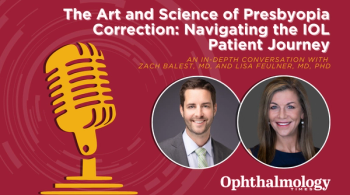
AMD progression associated with plasma metabolomic profiles
Ines Lains, MD, PhD, explores how mechanisms of AMD progression currently remain poorly understood and the tools to predict and halt progression are limited.
Reviewed by Ines Lains, MD, PhD
Metabolomics, defined as the qualitative and quantitative analysis of metabolites <1-1.5 kilodaltons, may be able to contribute to the understanding age-related macular degeneration (AMD) progression and the identification of patients at higher risk for progression, according to Ines Lains, MD, PhD, from Mass Eye and Ear, Harvard Medical School, Harvard University, Boston.
Speaking at the American Academy of Ophthalmology 2021 annual meeting in New Orleans, Lains explained that the mechanisms of AMD progression currently remain poorly understood and the tools to predict and halt progression are limited.
Previous work, both by our group at MEE and others, have shown that plasma metabolomic profiles of patients AMD differ from controls.
So far, no follow-up studies have been done. This study, for the first time, examined the association between metabolomics and AMD progression in a longitudinal study.
Longitudinal study of plasma metabolomics in AMD
Lains and the team, under guidance of Drs. Joan W. Miller and Deeba Husain, conducted a prospective longitudinal study to analyze the associations between baseline plasma metabolomic profiles and AMD progression at 3 years.
The main outcomes measures were AMD progression as documented in color fundus photographs (retinal structure) and changes in time to dark adapt (retinal function).
Study results
A total of 153 eyes were included in the study; of these, 26 with progression of AMD at 3 years.
The analyses showed that 8 metabolites were associated with AMD progression based on color fundus photographs, with an enrichment of the pentose and glucoronate interconversions pathway.
Additionally, metabolites in the alanine, aspartate and glutamate pathway were associated with 3-year changes in dark adaptation.
“In this study we observed that baseline plasma metabolomic profiles are associated with progression of AMD at 3 years,” Lains said. “In particular, the identified metabolites and metabolomic pathways are related to oxidative stress, suggesting that it may play a particularly important role in the progression of AMD both at structural and functional levels, as measured by dark adaptation.”
Lains concluded that the findings contribute to our understanding of mechanisms of AMD progression as well as the development of future biomarkers and potential therapeutics for this blinding disease.
--
Ines Lains, MD, PhD
E:
Laines reported no financial disclosures related to this content.
Newsletter
Don’t miss out—get Ophthalmology Times updates on the latest clinical advancements and expert interviews, straight to your inbox.









































